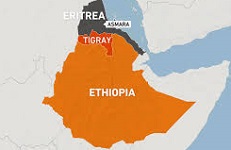In response to growing needs in Ethiopia’s Tigray region, the United States, through the U.S. Agency for International Development (USAID), is providing more than $152 million in additional humanitarian assistance.
The United States is the largest donor of humanitarian assistance in Ethiopia, and this latest announcement brings the total contributed by the American people for the people in Tigray to nearly $305 million. The humanitarian situation in Tigray continues to be dire, with approximately 4.5 million people in need of assistance and the UN warning that there could be a risk of famine. This new funding will address life-threatening hunger and acute malnutrition, as well as provide safe drinking water, urgently needed medical and health support, and shelter for some of the estimated one million people who have fled their homes.
USAID support will also provide protection for the most vulnerable—including safe spaces and psychosocial support for women and girls, case management for survivors of gender-based violence, training for social workers and community case workers, and programs to reunite children separated from their families.
Amidst considerable insecurity and humanitarian access constraints, USAID support will provide life-saving aid to more than 3 million people most in need in Ethiopia’s Tigray region. In addition to providing critical humanitarian aid, USAID deployed a Disaster Assistance Response Team (DART), which has been on the ground since March 1, 2021, to lead the U.S. Government’s response efforts.
“The United States remains deeply concerned about the ongoing humanitarian crisis in Tigray and the lack of sufficient humanitarian funding to address it. Large-scale assistance is urgently needed to prevent conditions in Tigray from worsening. The United States urges other donors to immediately increase their contributions to address Ethiopia’s critical humanitarian needs, and to help the most vulnerable people in the Tigray region. While the U.S.’s humanitarian assistance will help alleviate urgent needs, it will not address the root causes of the ongoing conflict and human rights violations in Ethiopia. An immediate cessation of fighting, dialogue, reconciliation, and accountability measures are needed to stop the suffering in Tigray,” the U.S. Embassy in Addis Ababa said in its statement.
Complex Emergency
Insecurity in parts of western and southern Ethiopia— including Benishangul-Gumuz Region’s Metekel Zone, Oromiya Region’s West Wollega Zone, and the Southern Nations Nationalities and Peoples (SNNP) Region’s Konso Zone—continues to drive widespread displacement and elevated humanitarian needs.
Nearly 13 million Ethiopians will likely require emergency food assistance through July due to conflict, drought, locust infestations, and COVID-19, according to food security monitors.
Ethiopian authorities and relief actors completed the first phase of a cholera vaccination campaign in late January, immunizing more than 1.6 million people in Gambella, Oromiya, Sidama, and SNNP regions.

